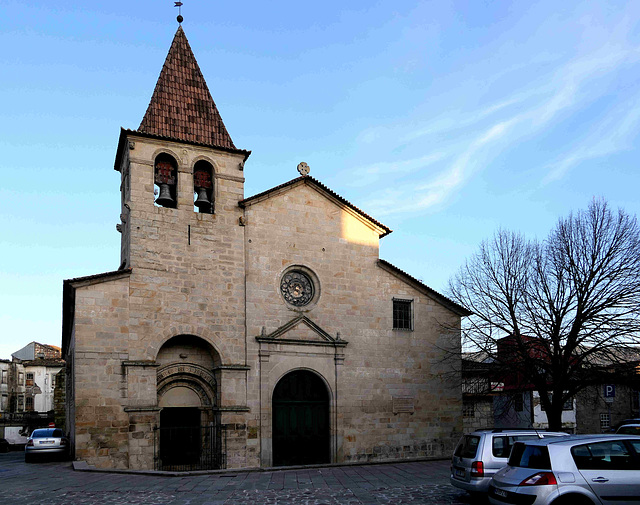St Basils Roman catholic church (fermée)
Tritt ein, tritt ein in den Dom!
Greece - Astros, Loukous Monastery
Church of Saint Benedict Monastery.
Church of Saint Benedict Monastery.
Organ.
Cloister of Saint Benedict Monastery.
Architectural details.
Greece - Nafplion, Church of Panagia
Chapel of Lord of the Calvary Steps.
HBM von der Plaza de San Francisco...
Greece - Lagia, Church of the Assumption
Villaviciosa - Santa María de la Oliva
Greece - Areopoli, Church of Agios Charalambos & P…
Greece - Nafplion, Church of the Transfiguration o…
Castañeda - Santa Cruz de Castañeda
New Church of Saint James.
Old Church of Saint James.
Basilika St. Kastor
Castañeda - Santa Cruz de Castañeda
Interior of the old Saint James Church.
Saint Anthony Chapel.
Pronstorf, romanische Feldsteinkirche mit Rundturm
Trier - Dom & Liebfrauenkirche
Eglise Notre-Dame de Boiscommun
Italy, Pienza, Duomo di Santa Maria Assunta
Greece - Elafonisos, Agios Spyridon
Dresden. Hofkirche
Vila Real - Catedral
St Mary the Virgin, Upchurch
Greece - Kalavryta, Monastery of Mega Spileo
St. Sixtus
Greece - Argos, Cathedral of St. Peter
Orgel in St. Marien
Kirche St. Marien in Plau am See
St.Marien-Kirche
St. Marien-Kirche
Greece - Feneos, Saint George Monastery
Lugo Iglesia de San Pedro
Happy Wall With Window Wednesday !
Greece - Feneos, Saint Fanourios Chapel
Happy Tower Tuesday !
Klosterkirche Malchow
Happy Bench Monday!
Ehemaliges Benediktinerinnen-Kloster Dobbertin
Location
Lat, Lng:
You can copy the above to your favourite mapping app.
Address: unknown
You can copy the above to your favourite mapping app.
Address: unknown
See also...
Keywords
Authorizations, license
-
Visible by: Everyone -
All rights reserved
-
62 visits
Chaves - Santa Maria Maior


People have lived in this area since the Neolithic period, but it has been continuously inhabited since the conquest by Roman legions, who established an outpost and took over the existing castros in the area. It developed into a military centre known for its baths. The Romans built defensive walls, spanned the river with a bridge, and exploited the local mines. The importance of the town led to it being elevated to the status of a city in 79 AD, during the reign of the first Flavian Caesar, which was also reflected in its name, Aquae Flaviae.
Rome's hegemony lasted until the 3rd century, when, successively, the Suebi and Visigoths as well as the Alani colonized the settlements of Chaves. The area surrendered to Islamic forces at around 714-716. The city was conquered by Alfonso I of Asturias in 773 and repopulated in 868 by Alfonso III of Asturias. Battles between Christian and Muslim forces then continued until the 11th century, when Alfonso V of León permanently reconquered Coimbra, establishing a firm buffer-zone to the south. He reconstructed, settled and encircled the settlement of Chaves with walls, in addition to establishing a Jewish quarter in the community. It was in the reign of Afonso I of Portugal that it was taken from León and firmly integrated into the Kingdom of Portugal domain (1160). Owing to its geographic location King Denis, ordered the construction of a castle to protect the kingdom's border.
It is said to have been the seat of a Christian bishopric as early as the Migration Period. The existing church is said to have been partially destroyed, and the Arab occupation led to the extinction of the diocese.
Documentary references to the church of Santa Maria Maior can be found in the Afonsinas Inquiries of 1259. The Romanesque church may have been built on top of another Visigothic building in the 12th century. The bell tower and portal of the medieval building remain.
Rome's hegemony lasted until the 3rd century, when, successively, the Suebi and Visigoths as well as the Alani colonized the settlements of Chaves. The area surrendered to Islamic forces at around 714-716. The city was conquered by Alfonso I of Asturias in 773 and repopulated in 868 by Alfonso III of Asturias. Battles between Christian and Muslim forces then continued until the 11th century, when Alfonso V of León permanently reconquered Coimbra, establishing a firm buffer-zone to the south. He reconstructed, settled and encircled the settlement of Chaves with walls, in addition to establishing a Jewish quarter in the community. It was in the reign of Afonso I of Portugal that it was taken from León and firmly integrated into the Kingdom of Portugal domain (1160). Owing to its geographic location King Denis, ordered the construction of a castle to protect the kingdom's border.
It is said to have been the seat of a Christian bishopric as early as the Migration Period. The existing church is said to have been partially destroyed, and the Arab occupation led to the extinction of the diocese.
Documentary references to the church of Santa Maria Maior can be found in the Afonsinas Inquiries of 1259. The Romanesque church may have been built on top of another Visigothic building in the 12th century. The bell tower and portal of the medieval building remain.
Dimas Sequeira, Alexander Prolygin have particularly liked this photo
- Keyboard shortcuts:
Jump to top
RSS feed- Latest comments - Subscribe to the comment feeds of this photo
- ipernity © 2007-2025
- Help & Contact
|
Club news
|
About ipernity
|
History |
ipernity Club & Prices |
Guide of good conduct
Donate | Group guidelines | Privacy policy | Terms of use | Statutes | In memoria -
Facebook
Twitter

Sign-in to write a comment.